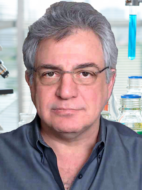Research Areas
The Department of Pharmacology at Vanderbilt ranks among the leading departments in the country and supports cutting edge research, drug discovery, education/training, and outreach efforts across the entire life science and medical research communities
Bioactive Lipids
Vanderbilt University and the Department of Pharmacology have international prominence in the area of bioactive lipid research. Our faculty are engaged in cutting edge research on the cyclooxygenase enzymes (targets of aspirin-related drugs) and their prostaglandin products; the isoprostanes (harbingers of oxidative stress); phospholipid transformations and their manipulation by phospholipase enzymes; and fatty acid bioactivation by lipoxygenase and cytochrome P450 enzymes with roles in homeostasis and inflammatory disease.
Cancer Biology
We collaborate with medical oncologists, surgical oncologists, bioengineers, cellular and molecular biologists, and scientists in pharmaceutical companies to address the scientific questions we are asking. This TEAM interaction enables us to optimize our studies to make important breakthroughs in tumor biology and tumor therapy. Our faculty work with an amazing group of postdoctoral fellows, graduate students, and laboratory scientists who dedicate their lives to providing better treatments for cancer patients.
Drug Discovery
The Department of Pharmacology is highly committed to advancing translation of basic science to novel therapeutic approaches and includes a number of investigators who are actively involved in drug discovery research. This spans a broad range of activities aimed at discovery of drug-like molecules that can be used to validate new molecular targets for treatment of human disease. In cases where early drug-like molecules have effects that support utility of a new approach for therapeutic intervention, the department has infrastructure and investigators with the expertise required to fully optimize novel drug candidates to achieve the properties required for advancing to clinical testing. The Warren Center for Neuroscience Drug Discovery (WCNDD) is a major focus of the Department of Pharmacology efforts and is heavily invested in discovery of novel drug candidates for treatment of major brain disorders. In addition, the department includes faculty with major interests in drug discovery for new approaches to treatment of cancer, cardiovascular disease, malaria, and other disease states. Finally, the department includes faculty whose research efforts are focused on drug disposition and new drug delivery systems that can be useful for multiple therapeutic areas.
Molecular Basis of Neuropsychiatric Disorders
Neuropsychiatry is the study of mental disorders arising from impairment in the brain. The Department of Pharmacology engages in research on the molecular and cellular basis of neuropsychiatric conditions. Faculty members investigate various mental disorders including addiction, depression, epilepsy, Rett syndrome, Parkinson’s disease, and Alzheimer’s disease. Some researchers examine specific neurotransmitters such as the dopamine receptor to understand the neural mechanisms in reward, motivation, and associative learning. Other laboratories study gene mutations such as the MeCP2 transcriptional regulator studied in Rett syndrome and stress-related disorders. Using techniques such as voltammetry, electrophysiology, and behavioral conditioning the department analyzes neurotransmitters and model specific behavioral aspects to distinguish the effects of these disorders and to determine potential treatments.
Neuronal Communication and Synaptic Signaling
Neurons communicate through both electrical and chemical signals in a process called neurotransmission. The electrical signals called action potentials get released at the synapse causing a chemical neurotransmitter to be released. The Department of Pharmacology studies the neural circuits in the brain, the function of synapses in neural circuits, and how these mechanisms of communication play a role in the treatment of neurological disorders.
Signal Transduction Mechanisms
Receptors reside in the plasma membrane that separates the cell from its environment. They serve as eyes and ears of the cell. Specialized receptors receive various external stimuli (hormones, neurotransmitters, light, odorant molecules, growth factors, etc.) and often with the help of transducer proteins translate this information into “cellular language”. Resulting changes in intracellular second messengers (cAMP, calcium, cGMP, IP6, etc.), influx of ions (sodium, potassium, calcium, chloride) from the outside via specialized channels, protein phosphorylation or dephosphorylation tells the cell what’s going on and makes it decide what to do. This is called signal transduction.
G protein-coupled receptors (GPCRs) are the largest family of membrane receptors, with ~800 different ones in humans, encoded by about 3% of our genes. GPCRs are targeted by a third of clinically used drugs. Active GPCRs activate cognate G proteins, which in their turn stimulate or inhibit various effector proteins. When the cell gets the message, active GPCRs are turned off by phosphorylation followed by the binding of arrestin proteins. Then GPCRs are moved inside the cell (internalized) and sorted: some are degraded, whereas others are returned to their original state, sent back to the membrane, and reused.
Structural Biology
Faulty cellular signaling underlies the majority of inherited and acquired human diseases. To design a successful therapeutic intervention that has a chance of bringing the signaling back into balance, we need to understand fine molecular mechanisms involved. Every signaling pathway in the cell is mediated by protein interactions with other proteins and small regulatory molecules, such as hormones, neurotransmitters, second messengers, metabolites, ions, etc. Comprehensive understanding of these interactions requires elucidation of the structures of signaling proteins and small molecules targeting them. Therefore, structural biology is an integral part of the research in the Department of Pharmacology. Faculty members performing these studies use all cutting-edge tools available, including X-ray crystallography, electronic paramagnetic resonance, nuclear magnetic resonance, fluorescent labeling, targeted design of small molecules and signaling-biased proteins with therapeutic potential, as well as molecular modeling that complements these experimental approaches.
























